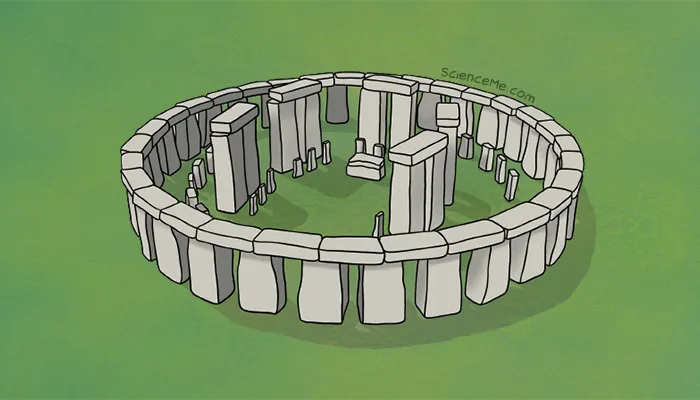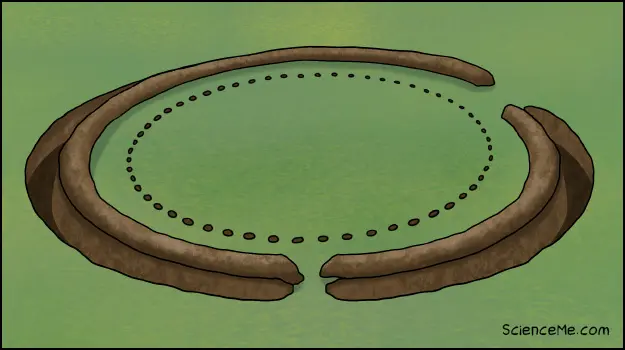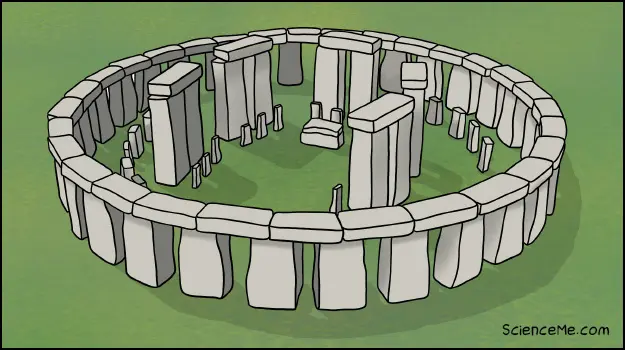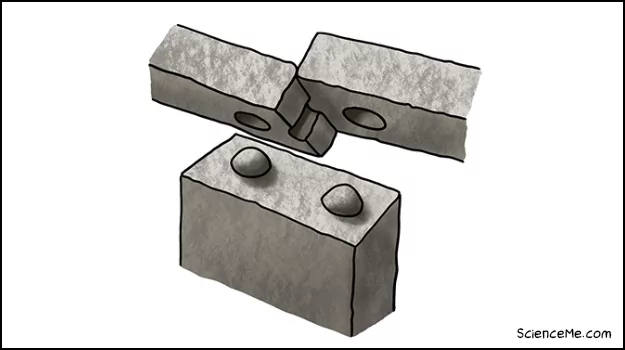Stonehenge was built 5,000 years ago by migrant farmers, who introduced bright ideas like agriculture and engineering to Britain's hunter-gatherers.

While fantastically famous, Stonehenge isn't even the biggest henge in Britain. That award goes to the little-known Marden Henge in Wiltshire; a 40-acre earthworks that's 10x larger. However, Stonehenge is the most architecturally sophisticated. And it's the only surviving lintelled stone circle, which I don't need to tell you means it has horizontal blocks.
Who Built Stonehenge?
I'm afraid it wasn't the Druids. Carbon dating has found Stonehenge was built a good 1,000 years before the Celts and their learned caste of high priests arrived in Britain. However, this doesn't stop people who identify as modern Druids from gathering at Stonehenge for the summer solstice each year.
Historians now agree that Stonehenge was built by Neolithic farmers who migrated from Anatolia to Britain some 6,000 years ago. This was part of a much larger migration that spread farming across Europe.

Stonehenge was originally built by migrant farmers hailing from what is now Turkey.
Genetic analysis of modern populations shows little mixing took place between the Anatolians and the native Britons. About 1,500 years after their arrival, they were replaced entirely by the Beaker People migrating in from the Netherlands. The genetic shift was so rapid that some historians point to an invasion.
While the Anatolians built the first stage of Stonehenge (3000-2500 BCE), it's likely the Beaker People built the circle of outer stones (2000 BCE).
What Was Stonehenge For?
Archaeologists have unearthed polished Stone Age tools at Stonehenge, as well as human remains which suggest it was originally a burial site. In the millennia that followed, it's likely the Beaker People used Stonehenge a ceremonial hub and a destination for religious pilgrimage.
Astronomers have long suggested there's a cosmic significance to the arrangement of Stonehenge. Some of the stones appear aligned with recurring astronomical phenomena like solstices, equinoxes, and eclipses. However, this hypothesis may be reaching: history suggests the Neolithic tribes didn't have the cosmological or mathematical knowledge to predict these kinds of events.
How Was Stonehenge Built?
Remarkably, Stonehenge was built in three phases over 1,000 years. The upside of such a prolonged construction is that nobody at the start of the project was still alive to complain about delays at the end.
Phase I: The Aubrey Holes
At a time when earthworks were all the rage, Stonehenge began as a series of holes. The Anatolian builders used picks made from deer antlers to create a massive ditch, a bank, and fifty large holes now known as the Aubrey Holes.

The Aubrey Holes were created around 5,000 years ago.
Stonehenge was used as a burial ground for the elite for at least 200 years. Although many of the bodies were cremated, the ashes still contain strontium isotopes. This reveals that many of the deceased actually lived for some time in Wales, more than 225 km (140 miles) away.
The Aubrey Holes may have provided the foundations for a wooden construction, or were simply to mark the graves of the deceased. But there were no stone monuments at this point. (In fact, any ring-shaped bank and ditch from the Neolithic period qualifies as a henge; stone monuments are a bonus feature.)
Phase II: The Bluestones
The nearest hardware shop must have been busy, or closed, or not invented, because it was 500 years before Stonehenge got an upgrade. Around 4,500 years ago, 82 bluestones weighing 3,500 kg (7,700 lb) each were carved out of the Preseli Hills in Wales and brought to the site.
It's possible the bluestones were shipped along waterways, then rolled along on logs like a conveyor belt across the land. With steady mental and physical leverage, the stones were eventually heaved into two concentric semi-circles.

The Bluestones were erected around 4,500 years ago.
No-one knows why the graveyard was converted to a monument containing half of the Welsh lithosphere. But by Jove that's what they did.
Phase III: The Sarsen Stones
Stonehenge got a further upgrade another 500 years later when the Beaker People took over and tinkered with the arrangement. It involved the construction of 30 sarsen stones, weighing 22,000 kg (50,000 lbs) each. That's about five male elephants per stone, if you prefer your measurements in elephants.
The sarsen stones came from the Marlborough Downs, some 32 km (20 miles) away from Stonehenge. What really takes the biscuit is that they did this before the invention of the Bronze Age wheel.

The Sarsen Stones were shifted into place around 4,000 years ago.
How Many People Built Stonehenge?
For a long time, historians presumed Stonehenge was built by hundreds, if not thousands, of coordinated workers. Today, we know that Stonehenge could have been built with a relatively small team of builders and the correct application of physics.
Wally Wallington, a retired builder from Michigan, demonstrates how Stonehenge was built in principle. In the video below, Wallington singlehandedly manipulates stone monoliths with simple machines like levers, pulleys, inclined planes, and wedges.
Stonehenge builders used a range of mechanical techniques to get the job done. Examination of the stones even reveal woodwork joinery methods like protruding tenons, mortice holes, and good old tongue-and-groove joinery.

The Sarsen Stones were fastened using traditional woodwork joinery.
The largest remaining stone is 8.7 metres tall, a third of which is now underground. Charles Darwin blamed the vigorous bioturbation habits of earthworms causing the stones to sink into the ground.
The Future of Stonehenge
Research is ongoing at Stonehenge: ground-penetrating radar, magnetometers, and other 3D mapping technologies are generating piles of new data. In the process, new henges have been discovered nearby, along with more clues as to why Stonehenge was built.
And yet, without some time-dilating window on the past, we'll never definitively know how Stonehenge was built, nor why henges were so very important to the religion of Neolithic cultures.
"Those vast stones, standing in concentric rings in the middle of a basin on Salisbury Plain, carefully placed by who-knows-who thousands of years ago, must mean something. But nobody can tell us what. Not exactly. The clues that remain will always prove insufficient to our curiosity. Each archaeological advance yields more questions, and more theories to be tested. Our ignorance shrinks by fractions. What we know is always dwarfed by what we can never know." - Ed Caeser, The Smithsonian







